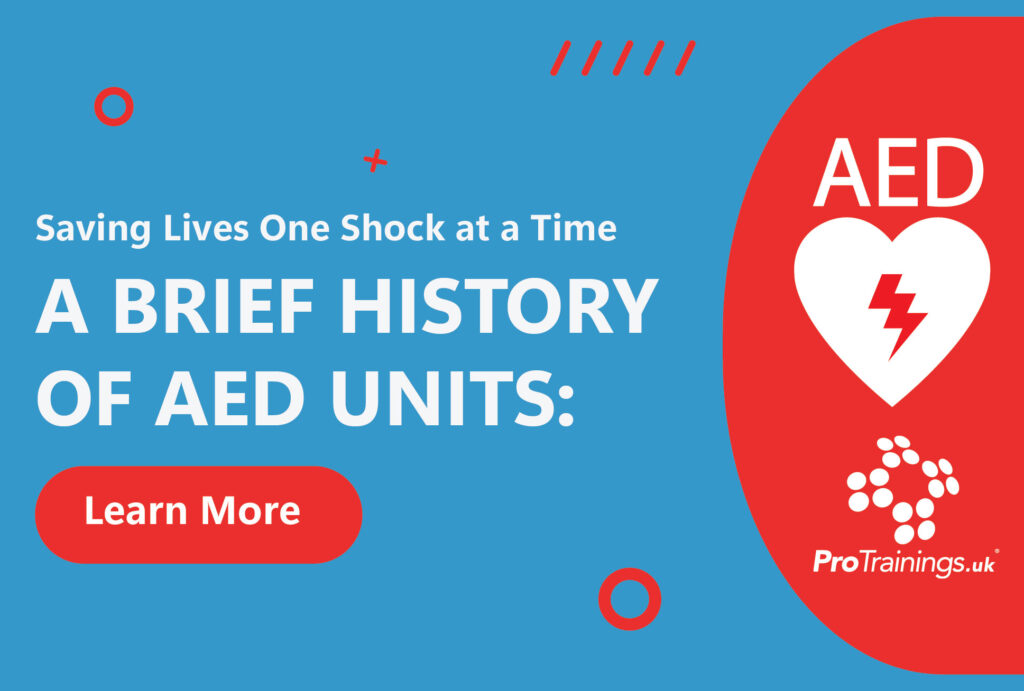A Brief History of AED Units:
Saving Lives One Shock at a Time
Automated External Defibrillators (AEDs) are now a common sight in public spaces, workplaces, and schools, playing a crucial role in saving lives during sudden cardiac arrest (SCA) incidents. But how did these lifesaving devices come to be? The story of AEDs is a testament to the power of medical innovation, driven by the need to improve emergency response and reduce the staggering number of deaths caused by cardiac arrest.
The Early Days of Defibrillation

The journey toward AEDs begins with the development of defibrillation itself. In the late 19th century, researchers began experimenting with electricity’s potential to treat heart conditions. The first recorded use of electric shocks to restore a regular heartbeat came in 1899, when Swiss physiologists Jean-Louis Prevost and Frédéric Batelli demonstrated that electric currents could induce ventricular fibrillation (a dangerous, erratic heart rhythm) in animals and then reverse it.
1930s: The First Human Defibrillations
It wasn’t until the 1930s that defibrillation was used on humans. Dr. Claude Beck, a pioneer in cardiac surgery in the United States, successfully applied electrical shocks to restart the heart of a young patient during surgery in 1947. This was a significant breakthrough, but the equipment at the time was bulky and complex, making it impractical for use outside of hospital settings.
1960s: The Portable Defibrillator
In the 1960s, a Scottish surgeon named Dr. Frank Pantridge revolutionised emergency care with the introduction of the first portable defibrillator. Working in Belfast, Pantridge recognised the critical need for rapid intervention during cardiac emergencies. The result was a portable defibrillator that could be used by emergency medical teams in the field. While still weighing around 70 kg (150 lbs), it was a major step forward in bringing defibrillation to patients more quickly.
1970s: The Birth of the AED
As technology improved, the idea of a fully automated defibrillator began to take shape. The goal was to create a device that could not only deliver a shock but also analyse the heart rhythm and determine if a shock was necessary, all without the need for a highly trained operator.
The first AEDs began to emerge in the late 1970s, developed by researchers and engineers looking to make defibrillation more accessible. These early models were designed for use by emergency personnel, particularly those in ambulances, who often reached patients before they arrived at the hospital. The key innovation was the device’s ability to detect life-threatening arrhythmias, such as ventricular fibrillation, and only deliver a shock if needed, significantly reducing the risk of inappropriate shocks.
1980s and 1990s: Widespread Adoption
During the 1980s and 1990s, AED technology continued to evolve, becoming smaller, more affordable, and easier to use. The development of biphasic waveforms in the early 1990s—where the electrical shock is delivered in two directions across the heart—made defibrillation more effective while using less energy.
Public awareness of AEDs grew as governments and health organisations began pushing for their placement in public areas like airports, shopping centres, schools, and stadiums. Studies showed that quick access to defibrillation greatly improved the chances of survival for individuals suffering from sudden cardiac arrest, especially when combined with CPR.
Modern AEDs: User-Friendly and Life-Saving
Today’s AEDs are lightweight, portable, and designed to be used by anyone, regardless of medical training. Clear voice prompts guide the user through each step, from attaching the pads to administering the shock. Most modern AEDs also include CPR prompts to ensure that high-quality chest compressions are performed between shocks, improving the overall effectiveness of the response.
With the widespread placement of AEDs in public areas and the growing emphasis on CPR and AED training, more people are prepared to act quickly in the event of a cardiac emergency. The global effort to make AEDs available has dramatically increased survival rates for out-of-hospital cardiac arrests.
Looking Ahead: The Future of AEDs
Technology continues to improve, and the future of AEDs looks promising. Advances in data collection, wireless connectivity, and integration with emergency services mean that modern AEDs can transmit vital information to paramedics before they arrive, further improving outcomes.
With ongoing research and developments in cardiac care, the accessibility and effectiveness of AEDs will likely continue to grow, bringing life-saving technology to more people around the world.
Conclusion
The history of AEDs is one of innovation and progress, driven by a desire to save lives in critical moments. From the first experiments in defibrillation to the portable, user-friendly devices we see today, AEDs have transformed emergency response and helped to significantly improve survival rates for sudden cardiac arrest victims. Thanks to these innovations, countless lives have been saved, and the potential for more is greater than ever.
|
ReplyForward
|
